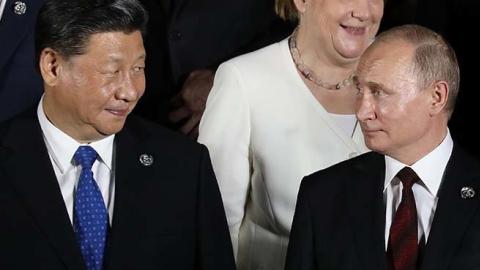Russian and Chinese military aircraft probed South Korean and Japanese air defenses last week, leading the South Koreans to fire more than 300 warning shots before the intruders departed.
This was just the latest manifestation of a deepening alliance between Russia and China. James Dobbins, Howard Shatz and Ali Wyne described the emerging alignment in an April essay in the Diplomat. In 2016, Russia displaced Saudi Arabia as China’s largest source of imported oil. In 2017, the two countries held their first joint naval exercise in the Baltic Sea. In June 2018, Xi Jinping called Vladimir Putin “my best, most intimate friend,” and later that year Chinese forces participated in the largest military exercise on Russian soil since 1981.
The departing director of national intelligence, Dan Coats, says the two Eurasian supergiants are as close as they were in the 1950s. From Venezuela to Syria to Serbia, they are working to frustrate the West. They are also increasingly cooperating in sub-Saharan Africa and have found ways to reduce their competition in Central Asia.
Many analysts discounted the prospects for deep Sino-Russian coordination. Mr. Putin’s overarching foreign policy objective has long been to build up Russia as an independent great power between Europe and China; a close alliance with a rising China works against this goal. Tensions along their lengthy border, commercial rivalries, and Russian suspicion of Chinese designs on its Far Eastern territories tend to drive the two countries apart. Given Russia’s slow decline and China’s rapid rise, some expected Russia would support Western efforts to balance China rather than undermine them.
Instead Moscow seems to have concluded that the door to the West is closed. The European Union is too weak, too indecisive and too liberal to serve as a strategic partner for Mr. Putin’s Russia. President Trump is too mercurial and Congress too hostile for the U.S. to meet Russia’s needs. That leaves a stark choice between an alliance with China and isolation.
There is another factor driving Moscow and Beijing together. The circus atmosphere of the Trump presidency sometimes obscures this, but the past few years have witnessed a marked increase in American power. Washington’s reach is expanding, its ability to enforce its will on others has grown, and it has become more willing and able to use its power disruptively. Moreover, as recent protests in Moscow and Hong Kong demonstrate, liberal ideas still have the power to challenge the world’s autocrats. Russia and China have decided to work together more closely in large part because both countries are more worried about the U.S.
Intelligent people disagree about the wisdom of the Trump administration’s Iran policy, and success is far from certain—but as a demonstration of American power, the economic isolation of a major oil producer in the teeth of stiff European, Chinese and Russian opposition is an extraordinary spectacle. To Russia—another major oil producer dependent on trade with the West that has felt the bite of American sanctions—it is terrifying.
Three factors contribute to this surge in American power. First, the success of fracking and related technologies together with the increased use of renewable energy in the West makes world energy markets more resilient. Oil prices are stable and relatively low even though Iran and Venezuela have essentially been forced out of the market.
Second, the growing sophistication of information technology means that U.S. authorities can track complex transactions and enforce secondary sanctions to an unprecedented degree. European governments have been shocked to discover that they cannot protect national companies wishing to do business with Iran from American law. Moscow and Beijing cannot help but notice that these tools could one day be turned against them.
The third factor is Mr. Trump. By using trade and tariffs as weapons in unrelated negotiations, the president has increased America’s clout. European efforts to resist U.S. sanctions on Iran, for example, must be carried out in the shadow cast by Mr. Trump’s threats to impose massive tariffs on key European products on vaguely defined “national security” grounds.
Mr. Trump’s critics argue that Washington can’t afford to alienate longtime allies as adversaries coalesce against the U.S. They also warn that the institutions that constrained great-power competition are decaying at an accelerating pace. And businesses around the world need the kind of policy predictability that Trump-era diplomacy is steadily eroding.
True enough, and worrying—but the new world disorder has deeper causes than Mr. Trump. There are two rising great powers in the world today—not just one—and the U.S. as well as China is developing a more expansive view of its interests as its power grows.
China has responded to the newly competitive international situation by deepening its relationship with a strategic partner. Combine the jostling ambitions of two rising world powers with the disruptive economic, military and cultural consequences of the information revolution, and the causes of our distemper are easier to understand if not, unfortunately, to resolve.


















